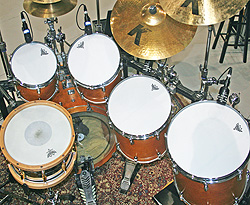

- #MIXING LIVE SOUND DRUMS HOW TO#
- #MIXING LIVE SOUND DRUMS PRO#
- #MIXING LIVE SOUND DRUMS TRIAL#
- #MIXING LIVE SOUND DRUMS PROFESSIONAL#
(When you master it mixing gets A LOT easier.) The most important knob on a mixing console. (You will automatically start mixing better when you understand this.)

The demystifying truth about gain structure and unity gain.
#MIXING LIVE SOUND DRUMS HOW TO#
How to quickly identify and eliminate feedback frequencies. The biggest - and maybe most common - mistake engineers make with compression. Why understanding signal flow is absolutely essential for keeping your cool and quickly solving problems on stage in stressful situations.
#MIXING LIVE SOUND DRUMS PRO#
(You MUST master this skill as a pro live engineer.) The one piece of gear that’s responsible for 90% of live sound failure.Ī step-by-step guide for running soundcheck. That's why I created Live Sound Essentials.Ĭlear and straightforward advice that will instantly improve your live mixes and ability to troubleshoot problems.
#MIXING LIVE SOUND DRUMS TRIAL#
You either had to pay tens of thousands of dollars for audio school, or try and figure it out through A LOT of trial and error. There wasn’t affordable, practical information out there for live engineers. It took me years to get my knowledge to a level where I was comfortable mixing big shows. The frustrating part is I could’ve drastically accelerated the process if I’d had access to quality “street smart” live sound resources. So, like many live engineers, I learned everything on the job. All the live sound resources were either outdated or useless - and when I asked more experienced engineers for help, they acted like the information was too precious to pass on. Back then, the hardest part of moving on to bigger gigs was I had to learn everything on my own. I've mixed the main stage at huge festivals for 60,000+ people and done headlining shows at Madison Square Garden, Staples Center in LA, and the Sydney Opera House.īut when I started out over 20 years ago, I felt fortunate just to get my first live sound job at a 300-capacity club in Iowa. The Man, Lizzo, Liz Phair, Macklemore, Fred Armisen, and Foster the People (all Grammy-nominated or -winning) have hired me to mix their performances.
#MIXING LIVE SOUND DRUMS PROFESSIONAL#
For much more on miking drums, check out our Recording Drums feature.As a professional touring FOH (Front of House) Engineer, I've been lucky enough to work with some amazing artists - for example: HAIM, Khalid, St. The fundamental (lowest) tones are particularly important in conveying power and punch, so high-pass filters and EQ can be handy to ensure that the fundamental tones of the kick and snare are supplied mostly by their internal and top mics respectively. This can be reduced using gates (to silence the signal between each hit) and EQ (to remove frequencies that belong to other drums/mics) on individual channels. Turning all these mics up at once will lead to undesirable interactions between the channels.
You may also encounter room mics, which are placed further from the kit to capture more of the recording space’s natural reverb. Overhead mics are the most commonly used – typically a stereo pair placed above the kit. When mixing, you can process the top and bottom mics to achieve the desired balance of oomph and sizzle.Īmbient mics capture the sound of the whole kit from a particular perspective. The latter captures the sound of the snare wires rattling, while the former captures the ‘thwack’ of stick striking skin. The snare drum most often uses two mics: one on the top head and another underneath, pointed at the bottom head. These can be blended to taste in the mix, provided they’re in phase (which we’ll come on to shortly). One mic inside the kick drum is sufficient, but some engineers also use an outside kick mic and maybe a special ‘sub’ mic to capture the low end.

Toms and cymbals are almost always single-miked. While it usually needs to be reduced with EQ and gating, you don’t necessarily want to eradicate it entirely, because a bit of bleed makes the kit sound more natural and cohesive. The other drums will inevitably be picked up in the background - this is called bleed or spill. There are two fundamental types: close and ambient.Ĭlose mics are positioned to capture the direct, ‘isolated’ sound from one drum or cymbal in the kit. To mix drums, you need to understand miking techniques. Incidentally, we’re only dealing with backbeat-orientated styles here jazz and gentler acoustic material require a looser, broad-dynamic approach. We’ll do it mostly using EQ, gates and compressors - your three most valuable drum mixing tools. We have two primary goals: achieving good separation between the elements of the kit, and imbuing our part with power, presence, character and ‘that pro sound’.


 0 kommentar(er)
0 kommentar(er)
